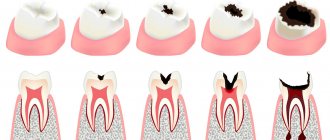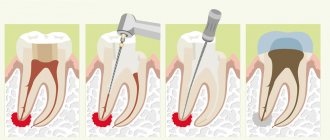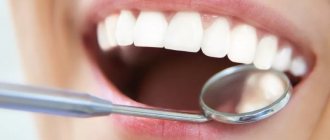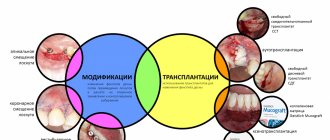From this article you will learn:
- why is the gum around the tooth swollen,
- The gum is swollen and hurts - what to do.
The article was written by a dental surgeon with more than 19 years of experience.
If your gums are swollen, what to do in this case will depend on the cause of the inflammation. There may be two main reasons. The first reason is associated with the development of periodontitis, i.e. inflammation at the apex of the tooth root (Fig. 1-3). The development of inflammation is associated here either with poor-quality dental treatment in the past, or with the lack of timely treatment. And in this case, you can always find a carious defect, filling or crown on the causative tooth.
The second reason that the gums are swollen and painful may be the development of localized or generalized forms of periodontitis in the patient. With these forms of gum inflammation, the attachment of the gingival margin to the neck of the teeth is destroyed - with the formation of so-called “periodontal pockets” between the gum and teeth (Fig. 4-6). In such gum pockets, good conditions are created for the growth of bacteria, which can also lead to the development of purulent inflammation in the gum pocket and the appearance of gum swelling.
Swelling of the gums due to periodontitis –
Swelling of the gums due to periodontitis -
A separate question in this article is what to do if the gums near the wisdom tooth are swollen. Most often this occurs in the lower jaw, and in this case the swelling of the gums is not associated with either periodontitis or periodontitis. This inflammation of the gums is called a special term - pericoronitis (which means inflammation of the “hood” over the wisdom tooth).
Content
- Causes of bleeding
- Possible complications
- Treatment regimens
- Prevention
If your tooth is bleeding, gum disease may be the cause. Inflammatory processes develop as a result of gingivitis and periodontitis, in the absence of proper oral hygiene. If there is pathology, bleeding can be caused even by regular brushing of teeth.
To fix a problem, you need to understand the cause of its occurrence. In some cases, it will be enough to eliminate the source of the problem; sometimes the approach to treatment should be complex, using medications.
PROMOTION
Dental restoration, installation of fillings
from 2200 rub.
How to quickly stop bleeding
If you suddenly suddenly start bleeding from your gums, you can stop it in the following ways:
- slight bleeding of the gums can be stopped with plain cold water or a special mint mouth rinse (if you don’t have it, you can use chamomile or calendula tincture diluted in warm water);
- buy homeopathic protective strips for the gums at the pharmacy and stick them on the affected area;
- You can stop bleeding from the gums using a cotton swab soaked in chlorhexidine (apply tightly to the sore spot and wait until the bleeding goes away).
Main causes of bleeding
Lack of proper oral hygiene. Injury to the gums and the formation of bruises can be caused by a hard toothbrush. Improper flossing can also cause injury.
Plaque and tartar, the accumulation of many microorganisms contribute to the rejection of teeth from the gums. The resulting gap fills with blood. In order not to provoke such a problem, you should brush your teeth thoroughly and regularly visit the dentist for preventive purposes.
A risk factor is changes in hormonal levels, including during pregnancy, disruption of the internal systems of the body, or simply with age. The result is looseness of the walls of blood vessels and their slight injury.
Infectious diseases of the oral cavity that develop as a result of the accumulation of harmful microorganisms and bacteria. The reason is poor oral hygiene, lack of timely treatment and professional cleaning. The result is bleeding from the tooth canal.
Swelling of the gums due to periodontitis -
In case of poor-quality root canal treatment, due to tooth trauma, or in the absence of timely treatment of caries and pulpitis, inflammation occurs at the apex of the tooth root, which dentists call “periodontitis.” Sometimes the terms “granuloma” or “cyst” are used to refer to periodontitis, which you may well have heard. Such names are due to the fact that the focus of inflammation at the apex of the tooth root in these cases has the appearance of a purulent sac.
Symptoms - usually periodontitis has a chronic asymptomatic course, or there is only slight pain when biting on this tooth. But sometimes periods of exacerbation of inflammation occur, and in this case, acute pain may first occur in the causative tooth (especially when biting on it), and a little later, swelling of the gums usually appears in the projection of the causative tooth. But sometimes pain may be completely absent, and patients complain solely that the gums near the tooth are swollen (Fig. 1-3, 7-9).
Please note that with periodontitis, the source of inflammation is located at the apex of the tooth root, i.e. quite deep in the bone tissue. Therefore, swelling of the gums during periodontitis usually develops not just in the projection of the causative tooth, but most often in the projection of the apex of the root of the causative tooth. And in multi-rooted chewing teeth - no less often in the projection of the bone interradicular septum. But periodontitis is not characterized by swelling of the interdental papilla or the gingival margin adjacent to the neck of the tooth.
In general, if you have swelling on the gum in one of your teeth, pain occurs when you bite on it, and there is a crown, filling or carious destruction on the tooth, and also if, in addition to swelling on your gums, you also have swelling of soft tissues face (again in the projection of the causative tooth) - you can definitely make a diagnosis of “Exacerbation of chronic periodontitis.” An X-ray of this tooth will allow you to accurately determine the cause of periodontitis and the required amount of treatment.
What treatment may be required -
As we said above, if the gums are swollen and painful, then in most cases the reasons are poor-quality filling of the canals, or the lack of timely treatment of dental caries and pulpitis. Only according to official statistics, root canal fillings are performed poorly by dentists in at least 60-70% of cases. The main errors during treatment are underfilling of root canals, poor obturation of root canals with filling substances, breakage of instruments, perforation of the tooth root...
As a result of this treatment, a focus of purulent inflammation appears at the apex of the tooth root. Moreover, in the absence of timely treatment of the tooth for caries and pulpitis, exactly the same focus of inflammation will appear at the apex of the tooth root, but only against the background of unsealed root canals. In Fig. 10-12 you can see how the inflammation at the apex of the tooth root looks like during periodontitis (on the diagram, x-ray and on the root of the extracted tooth) -
Below we describe several treatment options that may be possible for patients with gum swelling due to dental periodontitis. In any case, the doctor will first be forced to take an x-ray. The image will allow us to determine whether this tooth can be saved at all, the size of the inflammatory focus at the apex of the root, and whether root canals have been filled in this tooth previously. The treatment tactics will depend on the latter, and below we will tell you how to cure a tooth and remove swelling from the gums so that it does not appear again.
1) If the channels are not sealed -
If root canal treatment has not previously been carried out on this tooth, then standard treatment of periodontitis is carried out with mechanical treatment of the root canals and treatment of the source of inflammation behind the root apex. On your first visit, they will open your tooth, expand the root canals to allow pus to drain out through them, and leave the tooth open for several days, prescribing antibiotics and anti-inflammatory therapy.
If necessary, your dentist may then refer you to an oral surgeon to make a small incision in the gum to allow additional drainage of pus. After about 3-5 days, the doctor makes an appointment for a second appointment and, if the inflammation subsides, completes the mechanical treatment of the root canals and seals them - either first with a temporary medicinal paste, or immediately with gutta-percha (the latter depends on the size of the source of inflammation at the apex of the tooth root). You can read more about the treatment of periodontitis at the link above.
How the gum incision is made - significant swelling of the gums, or if your gums and cheek are swollen at the same time - indicates the formation of a large purulent abscess, which will require not only opening the root canals of the causative tooth, but also making an incision in the gums to release the pus. The incision is made under local anesthesia, the wound is then washed with antiseptics and a drain is inserted into it (see video below).
2) If the channels are sealed poorly -
If an x-ray shows that canal treatment has already been carried out previously and the cause of inflammation was incomplete filling of the root canals to the apex of the tooth root, then there are 2 treatment options: either standard conservative therapeutic treatment, or an option associated with resection of the root apex.
- Conservative therapeutic treatment - on the first visit, the filling/artificial crown is removed from the tooth, poorly filled root canals are unsealed, washed with antiseptics, and antibiotics are prescribed.
If necessary, the patient is referred to a dental surgeon to make an incision along the gum. Thus, to the treatment we described in the previous section, only 1 point was added here (unsealing the root canals). Then everything is the same - after the inflammation subsides, temporary or permanent filling of the root canals is carried out. If the source of inflammation is small, the canals are usually filled immediately and permanently with gutta-percha, and a permanent filling is placed at the next visit. If the inflammation is large, the canals are sealed with temporary medicinal paste for 1-3 months, and a temporary filling is placed. And only after this time the canals are filled with gutta-percha + a permanent filling or crown is placed. - Resection of the root apex (Fig. 13) –
This surgical method is much simpler and much cheaper than conventional therapeutic treatment, and it allows you to avoid removing the crown from the causative tooth in order to unfill and reseal the root canals.
However, this method is only suitable for those teeth in which the root canal was poorly filled only at the very apex of the root (and throughout the rest of the length the canal should be filled normally). This simple surgical operation is carried out within 25-35 minutes and consists of cutting off the apex of the root with the unfilled part of the root canal using a drill. To do this, an incision is made along the gum and a flap of the mucous membrane is moved back to give access to the bone tissue in the projection of the apex of the tooth root. Next, a small hole is made in the bone with a drill, through which the apex of the root is cut off and removed from the wound along with the granuloma/cyst at the apex. The wound is sutured and antibiotics are prescribed. Pros: cheap, simple, no need to remove the crown and re-treat the tooth.→ How is root resection surgery performed?
What complications are possible?
When, in addition to bleeding, there is an unpleasant odor coming from the mouth, you should immediately visit the dentist. At home, you can only rinse your mouth with an antiseptic. If such symptoms are not followed by treatment, complications will not be long in coming.
Many bacteria increase the risk of cyst formation; cystic formations can only be removed surgically.
The pathological process will cause destruction of the filling and crown, inflammation of the gum tissue. Treatment includes the use of medications and surgical removal of the infection.
The lack of timely treatment of pulpitis and caries aggravates the situation and ongoing inflammation completely destroys the teeth.
To eliminate the risk of complications, it is necessary to carry out a course of treatment in a timely manner.
Why shouldn’t bleeding gums be ignored?
Firstly, you will be haunted by bad breath, which will repel both those around you and those close to you. You will become more complex and less sociable.
And secondly, if you refuse treatment, you can lose healthy teeth. Bleeding gums can be caused by periodontitis, periodontal disease, stomatitis and gingivitis.
The treatment regimen includes:
- systematic professional teeth cleaning – removal of plaque and tartar;
- a course of physiotherapeutic procedures to relieve inflammation;
- sanitation of the oral cavity.
The next stage of treatment is home therapy: rinsing with disinfecting solutions (salt and soda, chlorhexidine).
For a purulent infection, the patient is prescribed antibiotics.
At home, you can independently use traditional medicine methods, including decoctions and infusions of medicinal plants:
- oak bark;
- chamomile flowers;
- sage herbs.
You can use these decoctions and calendula tincture as lotions on problem areas of the mouth.
Use of pharmaceutical products:
- fluoridated toothpastes with the addition of medicinal herbal extracts;
- dental anti-inflammatory gels (Cholisal);
- vitamin complexes.
Classification of bleeding
Bleeding is divided into primary, which begins immediately after surgery, and secondary, when bleeding begins after some time.
The intensity of bleeding is determined depending on how much the hole bleeds after removal:
1st degree
– blood flows
for 20-30 minutes
, saturates the tampons and colors the saliva.
2nd degree
– bleeding continues for more than 40 minutes, blood and saliva mix intensively.
3rd degree
– the bleeding does not stop for more than an hour, the patient spits blood.
With prolonged bleeding, the patient's general condition worsens. Weakness, dizziness appear, and the skin turns pale. Blood pressure drops, the heart begins to beat less frequently. In case of bleeding, dentists advise not to delay a visit to the doctor so that he can take measures to stop the bleeding and prevent the condition from worsening.
Interproximal cleaning
Using a brush alone will not help treat bleeding gums. Most dentists recommend flossing or flossing once a day. Wrap the floss around the tooth in a C shape and slide it up and down at the gum line several times. Go all the way before moving on to the adjacent tooth. Flossing your mouth daily for 2 weeks is usually enough to eliminate most cases of bleeding gums caused by gingivitis. For those who cannot floss, it is recommended that you purchase water floss or a product to help clean between your teeth.
How to floss your teeth
Many studies also suggest that flossing between teeth is more effective than using a toothbrush. This is caused by deep pockets that can be present in people with gum disease, as well as concavities around the natural tooth structure.
Even the best cleaning procedure cannot remove debris from between teeth, so it is important to find your own interproximal (interdental) cleaning method.
Flossing
Nutritional supplements
Some nutritional and dietary supplements help reduce bleeding and inflammation in the body. If a person is anemic, increasing the amount of iron in the diet can be achieved through dietary counseling or supplementation. Some essential oils can also reduce bleeding. Omega-3 rich foods, such as nuts and fish oil, reduce gum swelling, promote gum healing, and are also beneficial for overall health. Fibrous foods such as fresh vegetables help stimulate your gums and immune system.
Nutritional supplements
Why do my gums bleed?
They are a mucous membrane that covers the alveolar part of the lower jaw and the alveolar process of the upper. This shell wraps around the teeth in the area of their neck, protecting dental tissues from various damages, and the teeth themselves from falling out.
Bleeding of this mucous membrane, as a rule, is a symptom of some disease of the oral cavity or body. Under the influence of various factors, the tissues are weakened, and, as a result, the gums bleed. These are the reasons why this problem appears. They will be discussed in more detail below.
Folk remedies
They are sometimes included in the overall treatment strategy, and sometimes used as a temporary measure before going to the dentist.
If your gums bleed, the following folk remedies are usually used:
- Oak bark decoction. They rinse the mouth with it several times a day, as it strengthens the gums and helps eliminate the inflammatory process. The preparation is simple - you need to brew 1 tbsp. l. crushed oak bark in 1 glass of water. The product should be allowed to brew until it cools, decant, and then you can use it;
- Camomile tea. This plant is an effective antiseptic with healing and anti-inflammatory effects. Pour 1 tsp into a glass of boiling water. plants, after which the infusion should be left to cool. Next, it is expressed and used to rinse the mouth. The procedure must be performed several times/day;
- Sage tea. The plant is an excellent antiseptic that has a healing, anti-inflammatory effect. It is brewed at the rate of 1 tsp. for 1 cup boiling water. Cooled to room temperature and strained, the infusion is used for rinsing;
- Water pepper infusion. This is something you can rinse your mouth with to reduce bleeding. The plant helps strengthen the walls of blood vessels, thereby normalizing blood clotting processes. To prepare the product, add 1 tsp. raw materials 1 cup boiling water, let it brew. It is then expressed and used as a mouthwash;
- Horseradish or black radish juice. It must be freshly squeezed, and its properties are that it helps eliminate plaque and tartar. You need to mix 2 tsp. juice of one of the vegetables with wine (200 ml). You can not only rinse your mouth with it, but also use it as an immunomodulator, taking it orally in small portions.
Traditional medicine suggests using sauerkraut and freshly squeezed carrot juice as ways to combat the problem. Please note that the methods listed above only help eliminate the symptom, but do not help cope with the cause of its occurrence. Therefore, visit your dentist, and only with his permission, use or discard them.











